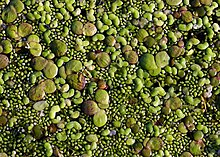Pleuston

The Pleuston ( Gr . Pleuston , "the sailing", "the floating") is the totality of the larger living beings floating on or on the water surface . The term is an analogy to “ plankton ” (“the wandering”) and was introduced into literature by Carl Schroeter and Oskar Kirchner in 1896.
Since the Pleuston can protrude completely or partially out of the water, it is more strongly drifted by the wind than by water currents compared to the plankton. A typical example of a Pleuston representative is the Portuguese galley ( Physalia physalis ) or the water strider ( Gerromorpha ).
The community of microorganisms adhering to the water surface is usually referred to as new clay . The distinction to the Pleuston is not uniform in the specialist literature .
According to Adolf Steuer, Ernst Hentschel differentiated the Pleuston into:
- Planktopleuston (e.g. drifting seaweed, jellyfish, salps )
- Nektopleuston (e.g. whales, flying fish, turtles)
- Pteropleuston (e.g. sea birds )
Individual evidence
- ↑ Stefan Nehring and Ute Albrecht (1997): Benthos and the redundant benthon: Neologisms in German-speaking limnology . In: Lauterbornia, Issue 31: 17–30, Dinkelscherben, December 1997 E-Text (PDF; 207 kB) ( Memento of the original from May 9, 2016 in the Internet Archive ) Info: The archive link was inserted automatically and has not yet been checked. Please check the original and archive link according to the instructions and then remove this notice.
- ^ Adolf control: The development of the German marine plankton research. On Ernst Hentschel's sixtieth birthday on February 25, 1936. In: Die Naturwissenschaften. Weekly for the advances in the pure and applied natural sciences, volume 24, published by Julius Springer (Berlin), issue 9, February 28, 1936, pp. 129–131
